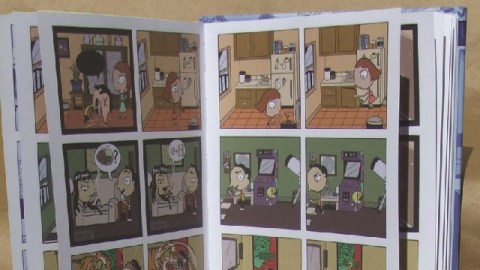Building a Better Comic Book

When Rodolphe Töpffer drew the first comics in 1837, he couldn’t possibly have imagined where the genre would go. It’s comparable to the Wright Brothers trying to picture stealth bombers while standing on the sands south of Kitty Hawk. Stealthily, comics have grown into one of the most fascinating forms of expression available—an alchemical mix of literature and visual art that achieves effects neither can produce alone. Jeff Zwirek’s Burning Building Comix explodes onto the scene with the latest comic pyrotechnics playing with the concepts of narrative and time itself. Stealthily simple but conceptually complex, Burning Building Comix puts Jeff Zwirek among the best and brightest architects building a better comic book.
Don’t judge Burning Building Comix by its cover, because it’s not until you open the book that you realize you’re in for a different comics experience. What looks like a horizontally oriented 6¼ by 12¼ inch book unfolds and stretches when opened into a 6¼ by 24½ inch tower of power. Zwirek takes full advantage of his unconventional format to create a visual and storytelling matrix striking in its originality.
The premise itself is simple—a 10-story building is burning down. Each story of the building’s a separate story featuring a character trying to survive. Zwirek asks you to start reading from the ground up. As you work your way up the towering inferno, the individual stories interact in your head, igniting new connections and imaginative possibilities. Zwirek achieves all this with a clean, concise visual style (shown above) and a total lack of dialogue. (Word bubbles appear with the context implying what’s said, but you’re left free to fill in the blanks.) On this framework, Zwirek hangs a varied cast of characters fighting the flames: a sleepy old woman and her frantic pooch, a pregnant wife going into labor, an obese shut-in, a pretentious film fan, a suicidal atheist, a resentful latchkey kid, a pentagram-drawing and video game-playing paganist, an abusive drunken couple, and a couple that find each other on the rebound and on different floors. Each story works horizontally, but from the first reading and even more from repeated readings, they work vertically, too. The visual and narrative parallels and contrasts Zwirek builds into his building show a great sophistication in storytelling.
Zwirek thanks, among others, cartoonist Ivan Brunetti, author of Cartooning: Philosophy and Practice (which I reviewed here). Burning Building Comix puts modern cartooning philosophy into practice in the best and most effective way. Zwirek doesn’t tell you his philosophy of comic creation, he shows you and makes you think the philosophy out for yourself. Alan Moore and Dave Gibbons’ Watchmen remains the standard for manipulating space and time, but if Watchmen is a grand, epic cathedral of storytelling, Burning Building Comix is a small, beautiful chapel. If you’re looking for the future of comics and where artists can take the medium, Jeff Zwirek’s Burning Building Comix will light your way.
[Image: Interior pages from Jeff Zwirek’s Burning Building Comix.]
[Many thanks to Jeff Zwirek for providing the image above and a review copy of Burning Building Comix, which is distributed by Top Shelf Comix.]





